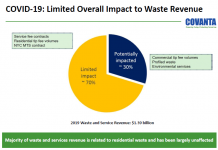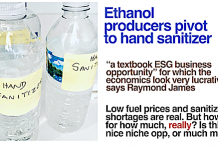Jim Lane
![360px-Sorghum_bicolor_%286442164465%29[1].jpg](http://www.altenergystocks.com/wp-content/uploads/2017/08/360px_Sorghum_bicolor__286442164465_29_1_.jpg)
Sorghum Bicolor photo by Matt Lavin
|
As Ceres points towards minimal plantings of its sweet sorghum hybrids in its key market of Brazil for next year, investors ask two questions.
Will sweet sorghum realize its vast potential, and when?
Just when many observers hoped that Ceres, Inc. (CERE) would dramatically expand hectares planted with its Blade hybrid sweet sorghum, the 2014 planting outlook was released last week and the total hectares crashed from 3000 in 2013 to 1000 in 2014.
It’s a far cry from the 8,000 hectares modeled earlier in the year by energy analyst Pavel Molchanov at Raymond James and back in spring 2012, energy analysts Michael Cox and Mike Ritzenthaler at Piper Jaffray wrote: “We are modeling Ceres sweet sorghum plantings to increase from 3,400 hectares to 25,000 hectares next season.”
And 2013′s result came in at 3,000 hectares.
The result? Ceres’ break-even has been pushed back to at least 2017. The company, which has $30 million on hand and is expected to burn $21 million in 2014 to cover development-stage losses, is going to need to raise capital in the next 12 months.
The opportunity
Now, it’s not a trivial feedstock in fact, it could well be key to health for the Brazilian ethanol sector. As Molchanov writes, “Ceres’ sweet sorghum provides a solution: it can extend a mill’s operations by ~60 days, yielding an estimated $9 million of EBITDA uplift.”
Why? As Ceres pointed out in its original IPO filing, “Due to the inherent limitations of sugarcane physiology and growth patterns, Brazilian mill operators, which have an estimated 3.4 million metric tons per day of crushing capacity, can only obtain usable sugarcane approximately 200 days per year.”
Accordingly, the company staked its sweet sorghum fortunes on Brazil. As we wrote in 2012: “The company’s IPO leans heavily on its prospects in Brazil, where growers and mills see an opportunity to extend mill operations by up to 60 days via sweet sorghum. Such an extension would add, at full capacity, as much as 10 billion gallons of ethanol production on existing land.” Ceres management added: “Our largest immediate commercial opportunity is the Brazilian ethanol market, which currently uses sugarcane as its predominant feedstock.”
The Risks
At the time of the IPO, Ceres shared many of the risks with prospective investors, mostly relating to scale-up and the time it takes for grower adoption. We translated some of those into English in our 10-Minute Guide to the Ceres IPO:
In IPOspeak: The markets for some of our dedicated energy crops are not well established and may take years to develop or may never develop and our growth depends on customer adoption of our dedicated energy crops.
In English: If biofuels and biopower do not scale globally, we are toast.
In IPOspeak: Our crops are new and most growers will require substantial instruction to successfully establish, grow and harvest crops grown from our seeds. A significant increase in the price of sugar relative to the price of ethanol may reduce demand for our sweet sorghum and may otherwise adversely affect our business.
In English: We hope not to be “Son of D1 Oils”.
In IPOspeak: We are at the beginning stages of developing our Blade brand and we have limited experience in marketing and selling our products. Our principal competitors may include major international agrochemical and agricultural biotechnology corporations, such as Advanta, Dow Chemical, Monsanto, DuPont and Syngenta, all of which have substantially greater resources to dedicate to research and development, production, and marketing than we have.
In English: Big Ag may swoop in and take away all our toys.
Competitive forces: Monsanto, DuPont and Syngenta
Is it low yields? Low levels of attentiveness from hard-presssed Brazilian ethanol producers; or a glut of seed players crowding into a development-stage opportunity?
Turns out, could be a combination of all three.
Among the traditional agriseed companies, Monsanto (MON), DuPont’s (DD) Pioneer unit and Syngenta have been actively taking an interest in bringing sweet sorghum to market. Syngenta paired up with Ceres, DuPont with NexSteep and Monsanto has been going it alone.
Hopes were high at one stage. In particular, Monsanto distributed seed equivalent to 20,000 hectares for the 2012 planting season, with 20 mills as customers and at the time, Jose Carramate at Monsanto told Bloomberg, “This year will be the magic year. We could see 100,000 hectares planted next year at the very least.”
Accordingly, it was cheery news for Ceres investors at the time of its 2012 IPO that “Management has claimed that early indications point to their hybrids performing better than those of their competitors.” Indeed, in product development trials and at the company’s breeding center (Note: where field evaluation plots are irrigated and managed more closely than commercial fields), Ceres hybrids averaged 80 or more metric tons per hectare. Subsequent field evaluations in the Southeast U.S. last summer confirmed similar results.
And, the company, under a DOE grant and in partnership with Amyris (AMRS), successfully demonstrated processing of their sweet sorghum into renewable diesel.
Ceres and Syngenta
So it, was doubly cheery news, when the company struck a sweet sorghum market development agreement with Syngenta in late 2012 and extended it just two weeks ago. Under the renewed agreement, Syngenta and Ceres will continue to collaborate on field evaluations with mills. Syngenta will evaluate its portfolio of crop protection products alongside Ceres hybrids, while Ceres will provide both seed and research support.
With 400+ ethanol mills in Brazil alone, the Syngenta partnership did much to boost seed marketing expectations for Ceres. But, it is not just a case of fending off Monsanto in a big market. There’s DuPont, as well.
DuPont and NexSteppe
DuPont made an equity investment in NexSteppe, and through its Pioneer Hi-Bred business, is providing knowledge, resou
rces and advanced technologies to help the company accelerate the breeding and commercialization of new hybrids of these crops in the United States and Brazil.
Um, who is NexSteppe?
NexSteppe is developing sweet sorghum, high biomass sorghum and switchgrass to produce feedstocks tailored for these biobased industries. NexSteppe is also refining crop management practices and supply chain operations to provide optimized, fully-integrated feedstock solutions. The company was founded just a couple of years back by CEO Anna Rath, who raised $14M in the company’s Series B investment round and counts Braemar Energy Ventures, DuPont, CYM Ventures and Zygote Ventures among the investor group.
The focal points? As with Ceres, a germplasm collection, breeding team and technology platform. The company also indicates thus: NexSteppe: “We are dedicated to overcoming the difficulties faced by processors of our crops, from process-specific compositional optimization to location-specific crop management practices to project-specific feedstock supply-chain solutions.”
Yields
According to Molchanov, “Ceres stated that greater-than-expected variability in the yield data from this past season would cause FY14 plantings to “grow more modestly than originally anticipated.” That’s couched in pleasant terms, but the reductions caused Molchanov to reduce his share price target from $20.00 to $1.97 in recent months.
Grower adoption rates
Now, the presence of so many seed options, and yield troubles, invariably will press down hard on the acreage available to Ceres. But there’s a ray of hope.
Though hectares have dropped considerably, the number of mills doing trials has jumped from 30 to 50. In fact, one of the ongoing trends has been the sharp reductions in hectares per trial. In the case of Monsanto, the seed volumes covered 1000 hectares per mill. In the 2013 Ceres trial programs, that figure dropped to 100 hectares per mill. For 2014, the trials are down to 20 hectares per mill.
Good, though, to see that the number of trials has jumped to as much as 20% of the total number of mills.
What about the US Market?
Yep, there’s a US market, too, though far more fuzzy in exact potential, and longer-term in nature. Hence the focus of Ceres and NexSteppe on Brazil.
Another player, focused on the US, is Epec, which includes in its management ranks CEO Ron Miller, former Aventine CEO, and Executive Chairman Steve Vanechanos, Sweet Sorghum Ethanol Association Director, technology entrepreneur, and former member of the Board of Governors for the American Stock Exchange.
Last year, Epec hit the headlines when BioDimensions Delta BioRenewables announced a strategic equity investment from Epec. The investment, it said, will allow the company to install a demonstration sweet sorghum semi-works processing facility at Agricenter International in Memphis, as well as resources to accelerate technology and market development for sweet sorghum industrial sugars and co-products.
By last December, that collaboration bore fruit, when Delta BioRenewables delivered its first-ever commercial-sized batch of sweet sorghum juice to the Commonwealth Agri-Energy plant in Kentucky.
Kentucky has set itself as something of a center for sweet sorghum. In the summer of 2012, Southeast Biofuels was spotted promoting sweet sorghum in the Kentucky legislature as the Interim Joint Committee on Agriculture and Small Business meets. The company had at the time just produced over a million gallons of ethanol from sweet sorghum, and was developing a processing unit to fit on a tractor trailer, suitable for a small farm operation.
The bottom line
The real culprit here is fast-falling hectares per trial. Had the industry been recording the kind of averages that Monsanto delivered in 2011, we’d be looking at 50,000-80,000 hectares and investor sentiment would be quite different.
But “greater-than-expected variability” in the yield data is going to create a bottleneck for the sweet sorghum developers now just a drag on Ceres’ share price, but a drag on the upside in Brazilian ethanol margins if they cannot access the 60-day additional harvest window in the next few seasons.
And, with export opportunities constrained, producers will be watching the margins and yields more closely than in boom times when capacity and production is all that matters.
Jim Lane is editor and publisher of Biofuels Digest where this article was originally published. Biofuels Digest is the most widely read Biofuels daily read by 14,000+ organizations. Subscribe here.








